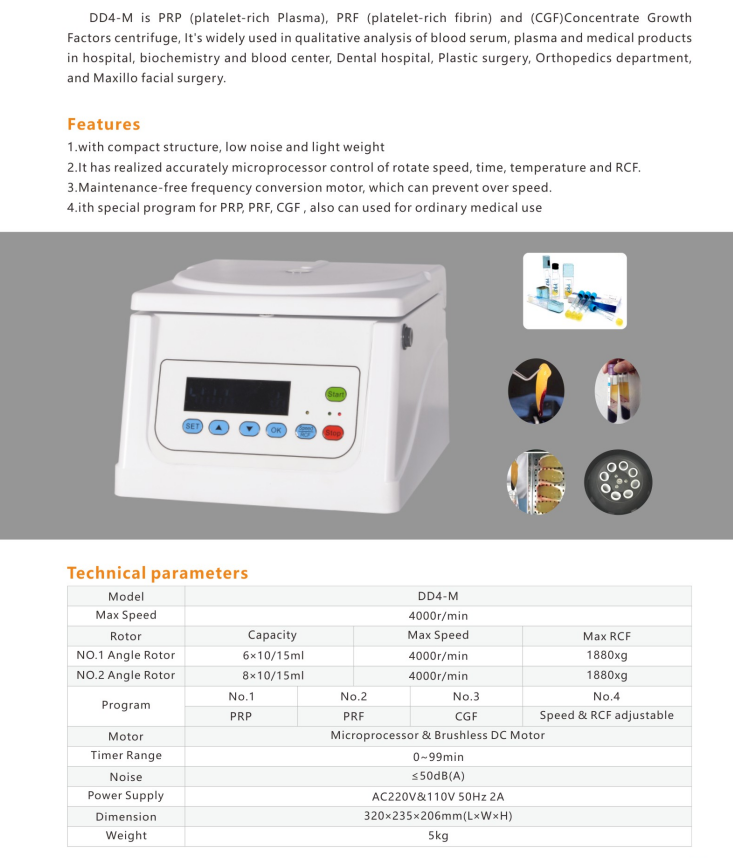
What is a PRP Centrifuge and used for?
2024-07-20 10:10What is a PRP Centrifuge and used for?
A Platelet-Rich Plasma (PRP) centrifuge is a specialized centrifuge designed to prepare platelet-rich plasma from a patient’s blood sample. PRP centrifuges are used in medical and cosmetic procedures to concentrate platelets, which are rich in growth factors and other proteins that aid in healing and tissue regeneration. The centrifuge separates the blood into its various components: red blood cells, white blood cells, plasma, and platelets, allowing for the extraction of the platelet-rich portion.
Applications of PRP Centrifuges
1. Orthopedics and Sports Medicine
Tendon and Ligament Injuries:
PRP therapy is used to treat injuries such as tendonitis, ligament sprains, and tears. The growth factors in PRP promote healing and reduce recovery time.
Joint Pain and Osteoarthritis:
Injections of PRP into joints affected by arthritis can reduce pain and improve function by promoting cartilage repair and reducing inflammation.
2. Cosmetic and Aesthetic Medicine
Facial Rejuvenation:
Known as the "vampire facial," PRP injections are used to rejuvenate the skin by stimulating collagen production, improving skin texture, and reducing wrinkles.
Hair Restoration:
PRP therapy is used to treat hair loss by injecting PRP into the scalp to stimulate hair follicles and promote hair growth.
3. Dermatology
Wound Healing:
PRP is applied to chronic wounds, such as diabetic ulcers and pressure sores, to accelerate healing by enhancing the body's natural repair processes.
Scar Treatment:
PRP can be used to improve the appearance of scars, including acne scars, by promoting the regeneration of healthy skin tissue.
4. Dentistry
Oral and Maxillofacial Surgery:
PRP is used to promote healing after dental surgeries, such as tooth extractions, implant placements, and periodontal treatments.
Key Features of PRP Centrifuges
Adjustable Speed and Time Settings:
PRP centrifuges offer precise control over centrifugation speed (RPM) and time to optimize the separation of blood components.
Rotor Compatibility:
They come with various rotors and adapters to accommodate different tube sizes and volumes, ensuring flexibility for different PRP preparation protocols.
Safety Features:
These centrifuges include safety features such as imbalance detection, lid locks, and automatic shutoff to ensure safe operation during the centrifugation process.
User-Friendly Interface:
PRP centrifuges typically feature easy-to-use digital controls and programmable settings to simplify the preparation process and ensure consistency.
Cooling Capabilities:
Some PRP centrifuges have refrigeration options to maintain low temperatures, protecting temperature-sensitive components in the blood sample.
Advantages of PRP Centrifuges
Enhanced Healing:
PRP therapy accelerates the healing process by delivering a high concentration of growth factors directly to the injury site, promoting tissue repair and regeneration.
Natural Treatment:
Since PRP uses the patient's own blood, the risk of allergic reactions or immune responses is minimized, making it a safe and natural treatment option.
Versatility:
PRP centrifuges are used across various medical and cosmetic fields, offering a wide range of therapeutic applications from orthopedics to dermatology.
Minimally Invasive:
PRP therapy is a minimally invasive procedure that can often be performed in an outpatient setting, reducing the need for surgery and associated recovery time.
Customization:
The ability to adjust centrifugation parameters allows for the customization of PRP preparations to meet the specific needs of different treatments and patient conditions.
Tips for Using PRP Centrifuges
Follow Protocols:
Adhere to established protocols for PRP preparation, including the recommended centrifugation speed and time, to ensure consistent and effective results.
Proper Sample Handling:
Handle blood samples with care to prevent clotting and contamination. Use anticoagulants as required and process samples promptly after collection.
Balance the Centrifuge:
Ensure that tubes are balanced in the centrifuge rotor to prevent excessive vibration and potential damage to the equipment or samples.
Maintain Equipment:
Regularly clean and maintain the centrifuge according to the manufacturer's instructions to ensure reliable performance and longevity.
Monitor Patients:
After PRP therapy, monitor patients for any adverse reactions and follow up to assess the effectiveness of the treatment and make any necessary adjustments.
